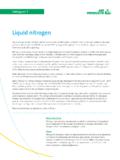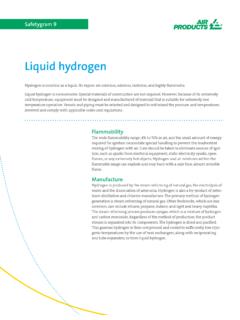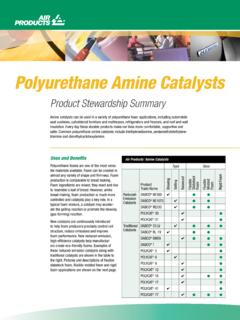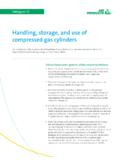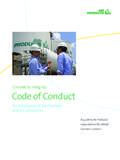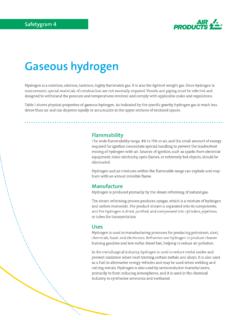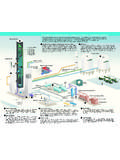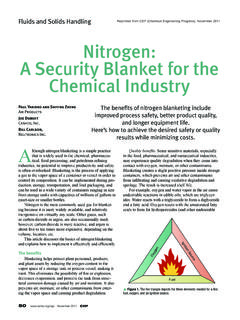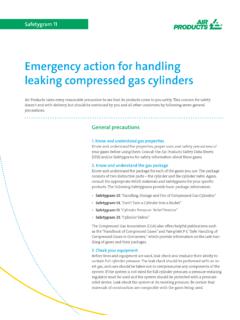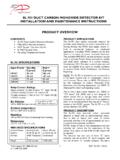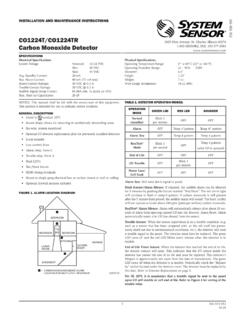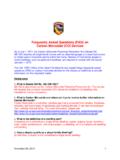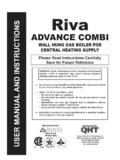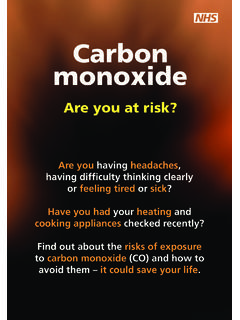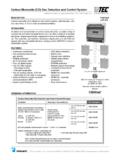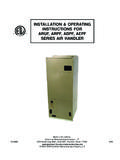Transcription of Carbon monoxide - Air Products & Chemicals
1 Carbon monoxide is a colorless, odorless, flammable, toxic gas. High-purity Carbon monoxide that is dry and free of sulfur compounds is normally noncorrosive to metals at atmospheric pressure. Lower-purity grades containing moisture, sulfur compounds and other impurities can form toxic metal carbonyls and can cause stress corrosion cracking in Carbon steels at elevated pressures. Chemically, Carbon monoxide is stable but can act as a strong reducing agent at elevated different grades of Carbon monoxide are available to support various applications. These grades range in purity from commercial grade at to research grade at monoxideApplications Carbon monoxide is used widely by the chemical industry in the production of inorganic Chemicals (metal carbonyls, titanium dioxide), organic Chemicals (benzaldehyde and citric acid), and chemical intermediates (toluene and diiso-cyanates, used to produce polyurethane).
2 Carbon monoxide in combination with several other gases (hydrogen, nitrogen, methane and Carbon dioxide) provides a fuel gas, called syngas, which is used as a substitute for natural gas. It is also used as a reducing agent in metals refining. Food packaging atmospheres sometimes incorporate limited concentrations of Carbon monoxide in meat, poultry and fish to maintain wholesomeness and provide flexibility in Most Carbon monoxide is manufactured by steam reforming natural gas. Other methods of manufacture include incomplete combustion of carbonaceous ma-terials, dehydration of formic acid with sulfuric acid, reduction of Carbon diox-ide over hot coke and by reacting Carbon and oxygen at elevated considerationsToxicity Carbon monoxide is toxic; the risk of exposure is increased because Carbon monoxide is odorless.
3 Carbon monoxide is a chemical asphyxiant which com-bines chemically with hemoglobin in blood to inhibit the transfer of oxygen through the circulatory system. The affinity of Carbon monoxide for hemo- globin is approximately 200 times that of oxygen. Because Carbon monoxide combines preferentially with hemoglobin to the exclusion of oxygen, oxygen cannot be transported to tissues and organs, resulting in oxygen starvation. This strong affinity of Carbon monoxide for hemoglobin means that small amounts of the gas may pose serious problems. The Carbon monoxide -hemoglobin bond is reversible, and the gas is gradually released if uncontaminated air is 192 PressureCarbon monoxide is shipped as a com-pressed gas at pressures up to 2000 psig. Pressure is stored energy and must be handled correctly to prevent uncontrolled releases.
4 A compressed gas cylinder containing pressure can be propelled at speeds of greater than 35 miles an hour if the valve is accidentally sheared. Unsecured pressurized lines can also cause dam-age if uncontrolled pressure releases occur. Treat all pressurized contain-ers and equipment with respect and never perform maintenance or work on pressurized equipment. See Safetygram-14, Don t Turn a Cylinder Into a Rocket, for more monoxide is colorless, taste-less, odorless, and is detectable only by specific techniques or instrumenta-tion. For these reasons, special precau-tions are required when hazardous concentrations are mixed with air, Carbon monox-ide poses an immediate fire hazard. Carbon monoxide has a very broad flammability range. The flammable range, sometimes referred to as the explosive range, is the range of vapor concentration in air that will burn or explode if ignition energy is intro-duced.
5 The limiting concentrations for the range are the Lower Flammable Limit (LFL) and the Upper Flammable Limit (UFL). Any concentration be-tween the LFL and the UFL will burn or explode if an ignition source is introduced. Concentrations below the LFL are too lean to burn, while those above the UFL are too rich to burn. However, concentrations above the UFL should not be considered safe, because they will dilute at the inter-face with the atmosphere and pass through the flammable Flammability Limit (LFL): Flammability Limit (UFL): Temperature: 1148 F (620 C).Table 1: Carbon monoxide Physical and chemical PropertiesChemical formula COMolecular weight point @ 1 atm F CMelting point @ 1 atm F CCritical temperature F CCritical pressure psig 3499 kPa, absGas density @ 70 F ( C), 1 atm lb/ft3 g/cm3 Specific gravity (air = 1) Specific volume @ 70 F ( C), 1 atm ft3/lb m3/kgFlammability limits vol LFL 74% vol UFL 3 ContainersCarbon monoxide is shipped and stored in high-pressure cylinders, tube trailers or ISO modules, depending on the quantity required by the consum-er.
6 These containers are manufactured according to applicable codes and specifications for the temperatures and pressures A typical steel cylinder is a hollow tube with a closed concave base that permits the cylinder to stand upright. Aluminum cylinders have flat bases. The opposite end is tapered to a small opening that is threaded to accom-modate the installation of a valve. A threaded neck ring is attached to the tapered end to allow a protective cyl-inder valve cap to be installed. Carbon steel and aluminum are the primary materials of construction for Carbon monoxide . Aluminum is the preferred material because it eliminates the possibility of iron pentacarbonyl for-mation and stress corrosion cracking. Cylinders are sometimes manifolded together in a pack or bank to provide larger volumes while minimizing cylinder changes.
7 See Safetygram-10, Handling, Storage, and Use of Compressed Gas Cylinders, for more information about cylinders. Table 2: Exposure LimitsACGIH 8-hour Time Weighted Average (TWA) 25 ppmNIOSH Recommended Exposure Limit (REL) 35 ppmOSHA Permissible Exposure Limit (PEL) 50 ppmNIOSH Immediately Dangerous to Life and Health (IDLH) 1200 ppmLethal Concentration 50% of test subjects die (LC50) 1807 ppm ( ) (4 hr, rat), 3760 ppm ( ) (1 hr rat)Lethal Concentration lowest concentration for death (LCl0) 5000 ppm ( ), 5 minutes, human Table 3: SymptomsCO Concentration Time of Exposure Symptoms (ppm)25 8 hours TWA maximum exposure allowed in workplace50 Typical bloodstream level for a 1 pack a day smoker200 2 3 hours Mild headache, fatigue, nausea, and dizziness 400 1 2 hours Serious headache, other symptoms intensify, life threatening after 3 hours800 45 minutes Dizziness, nausea, convulsions, unconscious within 2 hours, death within 2 3 hours1600 ( ) 20 minutes Headache, dizziness, nausea, death within 1 hour3200 ( )
8 5 10 minutes Headache, dizziness, nausea, death within 1 hour6200 ( ) 1 2 minutes Headache, dizziness, nausea, death within 30 minutes12,800 ( ) 1 3 minutes Death4 Tube trailers, ISO modules, and ground storage tubesIf large amounts of product are re-quired, Carbon monoxide can be sup-plied in tube trailers or ISO modules. The most common configurations for these units are in eight tube bundles of 12 meter (40 ft) by 56 cm (22 in) diameter tubes. These units carry as much as 820 kg (1800 lb) of Carbon monoxide . Figure 1 shows a typical Carbon monoxide tube trailer. Some applications will require larger quan-tities than are practical to be delivered in cylinder quantities but do not have the room or the space requirements for tube trailers or ISO tube modules.
9 Ground storage tubes may be used to satisfy these applications. Ground tubes can be sized to various volumes to meet specific needs. Ground tubes are similar to the tubes used in tube trailers and ISO modules but are permanently mounted at the site. See Figure 2. They can be sized and mani-folded together to meet a customer s volume requirements while fitting within their space , connections, and pressure relief devicesValvesCarbon monoxide containers are sup-plied with a variety of valves, depend-ing upon the grade and application of the product . Each cylinder valve has its own specific operating require-ments. These include the correct way to open and close the valve. Please see Air Products Safetygram-23, Cylinder Valves, for identifying features, detailed operating instruc-tions, strengths and weaknesses, and cut-away drawings.
10 If you are not sure which valve is on your container, con-tact your supplier for 1: Typical Carbon monoxide Tube TrailerFigure 2: Typical Ground Tube Installation5 Commercial grade Carbon monoxide (typically > purity)Commercial grade is typically equipped with pressure-seal (back-seating) valves. The pressure seal valve is a handwheel-operated valve using a two-piece valve stem. Air Products recommends pressure seal valves be used in the fully open or back-seated position. Opening the valve fully causes the lower stem to ride upward on its threads until it physically con-tacts the upper stem and mechani-cally drives the upper stem s seal ridge into the packing ring. This improves the seal around the valve stem and helps to prevent leaks at the top of the valve.
